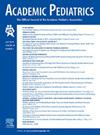儿科患者个体社会风险、社会需求和社区社会风险的差异
IF 2.8
3区 医学
Q1 PEDIATRICS
引用次数: 0
摘要
目的:我们试图探讨社区层面的健康社会决定因素(SDOH)、个人层面的社会风险因素和个人层面的社会需求之间的关系——家庭是否希望帮助解决社会风险因素——在太平洋西北地区一个庞大的、多样化的患者群体中。方法:我们对2017年12月1日至2019年12月31日期间在俄勒冈州和华盛顿州西南部的综合医疗保健系统Kaiser Permanente Northwest接受治疗的0-18岁儿童进行了回顾性队列研究。社会数据来自“你目前的生活状况”调查,记录在病人的电子病历中,包括住房不稳定、食品不安全、交通需求和经济困难等信息。我们使用卡方检验来比较社会风险、社会需求和NDI四分位数的比率。结果:样本包括2,313名儿童。在59.6%认可至少一项社会风险的家庭中,66.9%希望帮助解决至少一项社会需求。个人层面的社会风险和社会需求在不同的NDI四分位数之间存在显著差异,最高的社会风险和社会需求率处于最高的NDI四分位数(最不利的社会地位)。然而,在NDI最低四分位数(最具社会优势)的家庭中,42.1%的家庭承认至少有一种风险,23.3%的家庭承认至少有一种社会需求。结论:在不同的儿科患者样本中,我们发现社区水平的SDOH指数不能充分识别支持社会风险和社会需求的家庭。我们的研究结果支持在临床环境中激励个人层面的社会风险和社会需求数据收集的政策。本文章由计算机程序翻译,如有差异,请以英文原文为准。
Differences Between Individual Social Risks, Social Needs, and Community-Level Social Risk Among Pediatric Patients
Objective
We sought to explore relationships between community-level social determinants/drivers of health (SDOH), individual-level social risk factors, and individual-level social needs—whether families desire help addressing social risk factors—among children’s families in a large, diverse patient population in the Pacific Northwest.
Methods
We conducted a retrospective cohort study of children ages 0 to 18 who received care at Kaiser Permanente Northwest, an integrated health care system serving patients in Oregon and Southwest Washington, between December 1, 2017 and December 31, 2019. Social data came from the Your Current Life Situation survey as recorded in patient electronic medical records and included information on housing instability, food insecurity, transportation needs, and financial hardships. We used chi-square tests to compare rates of social risks, social needs, and Neighborhood Deprivation Index (NDI) quartiles.
Results
The sample included 2313 children. Among the 59.6% of families endorsing at least 1 social risk, 66.9% desired assistance addressing at least 1 social need. Both individual-level social risks and social needs varied significantly by NDI quartile, with the highest social risk and social needs rates being in the highest NDI quartiles (most social disadvantage). However, among families in the lowest NDI quartile (most social advantage), 42.1% of families endorsed at least 1 risk and 23.3% of families endorsed at least 1 social need.
Conclusions
In a diverse sample of pediatric patients, we found that a community-level SDOH index inadequately identified families endorsing social risks and social needs. Our findings support policies that incentivize individual-level social risk and social need data collection in clinical settings.
求助全文
通过发布文献求助,成功后即可免费获取论文全文。
去求助
来源期刊

Academic Pediatrics
PEDIATRICS-
CiteScore
4.60
自引率
12.90%
发文量
300
审稿时长
60 days
期刊介绍:
Academic Pediatrics, the official journal of the Academic Pediatric Association, is a peer-reviewed publication whose purpose is to strengthen the research and educational base of academic general pediatrics. The journal provides leadership in pediatric education, research, patient care and advocacy. Content areas include pediatric education, emergency medicine, injury, abuse, behavioral pediatrics, holistic medicine, child health services and health policy,and the environment. The journal provides an active forum for the presentation of pediatric educational research in diverse settings, involving medical students, residents, fellows, and practicing professionals. The journal also emphasizes important research relating to the quality of child health care, health care policy, and the organization of child health services. It also includes systematic reviews of primary care interventions and important methodologic papers to aid research in child health and education.
 求助内容:
求助内容: 应助结果提醒方式:
应助结果提醒方式:


